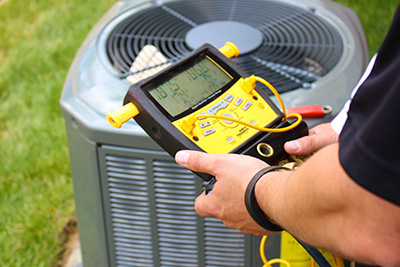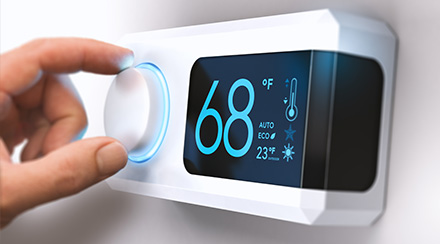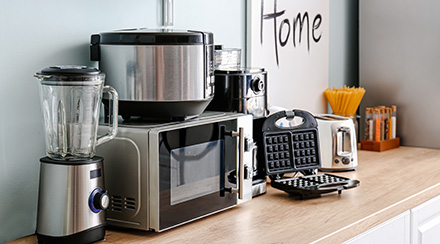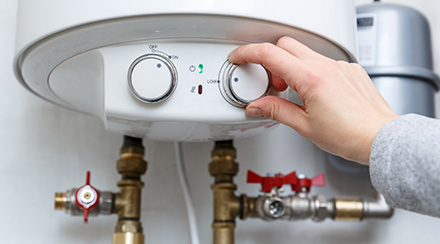Tips for Saving on Energy in Your Home
Ready to start saving on energy and lowering your monthly bills? If you’re looking to learn more about energy efficiency for home systems and appliances, we’re sharing our favorite energy-saving tips.
Heating and Cooling Energy Saving Tips

Most of the energy use in the typical home goes toward heating and cooling, so if you’re looking for ways to save energy, this is the place to start.
- Schedule annual maintenance. For air conditioner and furnace efficiency, annual maintenance is key, as well as heat pumps and swamp coolers. Annual maintenance, often called a "tune-up," usually includes a full system inspection, lubrication of moving parts, deep cleaning and top-off of fluids like air conditioner coolant. This service is the best way to maintain system efficiency, extend the life of the equipment and catch repair issues early, before they turn into bigger, more expensive problems.
- Change filters regularly. Your HVAC air filter protects your system and helps promote cleaner indoor air, but when it becomes clogged with dust and dirt, it restricts airflow. This forces your air handler to work harder, reducing energy efficiency and increasing wear-and-tear. Know where and how to change your filter, stock up on replacement filters and mark your calendar so you never forget to change it on time.
- Keep vents clear. Anything that restricts the flow of air through your vents can harm your energy efficiency. Ensure that vents are dust-free and unblocked by furniture, rugs and wall hangings.
- Seal your ducts. Gaps in your ductwork cause energy loss. If you can see or feel ductwork gaps in accessible areas like your attic or basement, you can patch these weaknesses with aluminum foil tape. Ductwork gaps in inaccessible areas are harder to patch, but not impossible – some HVAC specialists can circulate a mist of rubbery liquid through your ductwork that seals your ducts from the inside.
- Insulate your ducts. Wrapping exposed areas of your ductwork in insulation will help minimize energy loss as your treated air works its way to your vents. This can be especially helpful in large or oddly-shaped homes where air has to travel farther to reach the most distant vents.
- Upgrade your attic insulation. Insufficient insulation on your attic floor can allow your warm air to escape in the winter and let stifling summer heat radiate through your ceilings in the summer. The Department of Energy provides attic insulation standards based on your climate zone, so you can see if yours is up to snuff. But if you can see exposed floor joists when you look around in your attic, you probably need more insulation.
- Seal drafts. Drafts and air leaks waste energy by forcing your HVAC system to work more than it should, and they can come from all sorts of sources – doors, windows, mail slots, recessed lighting, gaps around plumbing pipes and more. You can try to locate drafts on your own using a handheld draft detector and use caulk or spray foam insulation to seal them. But for the most thorough draft detection, you can schedule a home energy audit in which inspectors will use infrared imaging to locate your home’s weak spots.
- Switch to a smart thermostat. When it comes to reducing your energy use, a smart thermostat is a smart upgrade. The smart thermostat is an improvement upon the programmable thermostat, which allows users to program heating and cooling schedules so that there’s less energy waste when the home is empty or occupants are asleep.
Energy Efficiency for Home Appliances and Fixtures
Furnaces and air conditioners may account for a big chunk of your home energy use, but those other appliances, electronics and fixtures can really add up. To make sure you’re maximizing efficiency throughout your home, consider these tips:
- Switch to LED bulbs. Not long ago, LED light bulbs were pricey and hard to find in stores. But today, they’re the standard – characterized by low prices, widespread availability and a huge selection of styles, including color-changing bulbs. Most importantly, LED bulbs use a fraction of the energy that their incandescent predecessors did, and they don’t give off unwanted heat in the summertime. LED bulbs last years longer, too.
- Upgrade to energy-efficient appliances. When it’s time to replace appliances or electronics, you can save in the long run by carefully shopping for energy-efficient models. Look for the yellow and black EnergyGuide label for detailed information on energy consumption, as well as the ENERGY STAR logo, which indicates which products meet the highest energy efficiency standards. Choosing energy-efficient models is most important with large appliances that draw lots of energy, including refrigerators, clothes dryers and oven ranges.
- Use energy-saving settings. Sometimes it’s hard to remember to turn off electronics when we’re done with them, so it’s helpful to use energy-saving settings where they’re available. Many computers and TVs have settings to help them automatically shut down after a period of inactivity, and internet-connected smart devices may have energy-saving settings for things like lighting, sound systems and even individual electrical outlets.
- Check your water heater settings. If you have a traditional tank water heater, it might be an energy hog in your home. Make sure you’re not wasting energy by keeping the temperature set no higher than 140 degrees Fahrenheit – but the temperature should be at least 120 degrees, which is sufficient to kill off most harmful bacteria. If you’re leaving your home for an extended period, you can save more by lowering the temperature or setting the thermostat to “vacation mode.” And for an even bigger efficiency boost, you can wrap your water heater tank in an insulating jacket designed specifically for water heaters.

Habits to Save Energy
Upgrading your appliances and maintaining your home can go a long way toward lowering your energy use, but you can save even more energy by adopting some new energy-efficient habits:
- Be vigilant against unnecessary energy use. Your parents nagged you about leaving the lights on for a reason – it’s a waste of energy! Challenge yourself to make sure lights, fans and electronics are turned off in unoccupied rooms.
- Hang-dry your clothes. Your clothes dryer consumes a lot of energy, so you can save money by hanging fresh laundry on the clothesline on sunny, breezy days. You can also buy compact drying racks for drying laundry indoors. If you choose to hang-dry only certain items and put the rest in the dryer, the smaller load will dry faster – so keep a close eye on your clothes and stop the cycle as soon as they’re dry!
- Use your dishwasher wisely. A dishwasher can help you save both water and energy, but it pays to run only full loads. You can save more by turning off the heated dry cycle and drying your dishes by hand. Some models even have energy saver settings, allowing you to use the most efficient cycle at the touch of a button.
- Don’t leave the door open. Not the door to the house, which lets your HVAC-treated air escape, nor the door to the refrigerator, which lets refrigerated air escape.
- Use major appliances early in the morning or after dark. If you wait until the evening to run the dishwasher, washing machine and dryer, you can avoid generating unwanted indoor heat during the day when it’s hottest in the summer. If you have time-of-day pricing with your electricity provider, you may also pay a lower energy rate in the evening hours.
- Consider where, how and when you cook. Everyone loves fresh-baked cookies, but it’s best to avoid firing up the oven in the middle of a hot summer day. Try to do your oven and stovetop cooking during the coolest hours of the day in the summertime, and cook more with countertop appliances or outdoor grills when outdoor temperatures are high.
- Participate in local energy efficiency programs. Some cities and municipalities have their own programs to help residents live more energy-efficient lives. You may even be able to get assistance for home upgrades. Check your local government websites to see if these programs are available where you live.
Looking for Something Specific?
Select a category to find resources for topics that interest you.
Select Category

Related Articles:

Tips for Improving Your AC and Furnace Efficiency
We share maintenance tips for your heater and AC, and home improvement tips to help you use those systems less.
Read Article
What Uses the Most Electricity In a Home?
We break down what uses the most energy in your home to give you an understanding of where your energy usage goes and where energy-saving tactics can make the most impact.
Read Article
Water Heater Energy Efficiency Explained
Unless you like taking cold showers, water heating is probably not something you can live without. But did you know that your water heater is one of the biggest energy-consuming appliances in your home?
Read ArticleMost Popular Articles

Energy Plans to Fit Your Lifestyle
NRG offers electricity and natural gas plans with perks like cash back, travel rewards and more, so you can find a plan that fits your home and family.
Tips for Saving on Energy in Your Home
Ready to start saving on energy and lowering your monthly bills? If you’re looking to learn more about energy efficiency for home systems and appliances, we’re sharing our favorite energy-saving tips.
Heating and Cooling Energy Saving Tips
Most of the energy use in the typical home goes toward heating and cooling, so if you’re looking for ways to save energy, this is the place to start.
- Schedule annual maintenance. For air conditioner and furnace efficiency, annual maintenance is key, as well as heat pumps and swamp coolers. Annual maintenance, often called a "tune-up," usually includes a full system inspection, lubrication of moving parts, deep cleaning and top-off of fluids like air conditioner coolant. This service is the best way to maintain system efficiency, extend the life of the equipment and catch repair issues early, before they turn into bigger, more expensive problems.
- Change filters regularly. Your HVAC air filter protects your system and helps promote cleaner indoor air, but when it becomes clogged with dust and dirt, it restricts airflow. This forces your air handler to work harder, reducing energy efficiency and increasing wear-and-tear. Know where and how to change your filter, stock up on replacement filters and mark your calendar so you never forget to change it on time.
- Keep vents clear. Anything that restricts the flow of air through your vents can harm your energy efficiency. Ensure that vents are dust-free and unblocked by furniture, rugs and wall hangings.
- Seal your ducts. Gaps in your ductwork cause energy loss. If you can see or feel ductwork gaps in accessible areas like your attic or basement, you can patch these weaknesses with aluminum foil tape. Ductwork gaps in inaccessible areas are harder to patch, but not impossible – some HVAC specialists can circulate a mist of rubbery liquid through your ductwork that seals your ducts from the inside.
- Insulate your ducts. Wrapping exposed areas of your ductwork in insulation will help minimize energy loss as your treated air works its way to your vents. This can be especially helpful in large or oddly-shaped homes where air has to travel farther to reach the most distant vents.
- Upgrade your attic insulation. Insufficient insulation on your attic floor can allow your warm air to escape in the winter and let stifling summer heat radiate through your ceilings in the summer. The Department of Energy provides attic insulation standards based on your climate zone, so you can see if yours is up to snuff. But if you can see exposed floor joists when you look around in your attic, you probably need more insulation.
- Seal drafts. Drafts and air leaks waste energy by forcing your HVAC system to work more than it should, and they can come from all sorts of sources – doors, windows, mail slots, recessed lighting, gaps around plumbing pipes and more. You can try to locate drafts on your own using a handheld draft detector and use caulk or spray foam insulation to seal them. But for the most thorough draft detection, you can schedule a home energy audit in which inspectors will use infrared imaging to locate your home’s weak spots.
- Switch to a smart thermostat. When it comes to reducing your energy use, a smart thermostat is a smart upgrade. The smart thermostat is an improvement upon the programmable thermostat, which allows users to program heating and cooling schedules so that there’s less energy waste when the home is empty or occupants are asleep.
Energy Efficiency for Home Appliances and Fixtures
Furnaces and air conditioners may account for a big chunk of your home energy use, but those other appliances, electronics and fixtures can really add up. To make sure you’re maximizing efficiency throughout your home, consider these tips:
- Switch to LED bulbs. Not long ago, LED light bulbs were pricey and hard to find in stores. But today, they’re the standard – characterized by low prices, widespread availability and a huge selection of styles, including color-changing bulbs. Most importantly, LED bulbs use a fraction of the energy that their incandescent predecessors did, and they don’t give off unwanted heat in the summertime. LED bulbs last years longer, too.
- Upgrade to energy-efficient appliances. When it’s time to replace appliances or electronics, you can save in the long run by carefully shopping for energy-efficient models. Look for the yellow and black EnergyGuide label for detailed information on energy consumption, as well as the ENERGY STAR logo, which indicates which products meet the highest energy efficiency standards. Choosing energy-efficient models is most important with large appliances that draw lots of energy, including refrigerators, clothes dryers and oven ranges.
- Use energy-saving settings. Sometimes it’s hard to remember to turn off electronics when we’re done with them, so it’s helpful to use energy-saving settings where they’re available. Many computers and TVs have settings to help them automatically shut down after a period of inactivity, and internet-connected smart devices may have energy-saving settings for things like lighting, sound systems and even individual electrical outlets.
- Check your water heater settings. If you have a traditional tank water heater, it might be an energy hog in your home. Make sure you’re not wasting energy by keeping the temperature set no higher than 140 degrees Fahrenheit – but the temperature should be at least 120 degrees, which is sufficient to kill off most harmful bacteria. If you’re leaving your home for an extended period, you can save more by lowering the temperature or setting the thermostat to “vacation mode.” And for an even bigger efficiency boost, you can wrap your water heater tank in an insulating jacket designed specifically for water heaters.
Habits to Save Energy
Upgrading your appliances and maintaining your home can go a long way toward lowering your energy use, but you can save even more energy by adopting some new energy-efficient habits:
- Be vigilant against unnecessary energy use. Your parents nagged you about leaving the lights on for a reason – it’s a waste of energy! Challenge yourself to make sure lights, fans and electronics are turned off in unoccupied rooms.
- Hang-dry your clothes. Your clothes dryer consumes a lot of energy, so you can save money by hanging fresh laundry on the clothesline on sunny, breezy days. You can also buy compact drying racks for drying laundry indoors. If you choose to hang-dry only certain items and put the rest in the dryer, the smaller load will dry faster – so keep a close eye on your clothes and stop the cycle as soon as they’re dry!
- Use your dishwasher wisely. A dishwasher can help you save both water and energy, but it pays to run only full loads. You can save more by turning off the heated dry cycle and drying your dishes by hand. Some models even have energy saver settings, allowing you to use the most efficient cycle at the touch of a button.
- Don’t leave the door open. Not the door to the house, which lets your HVAC-treated air escape, nor the door to the refrigerator, which lets refrigerated air escape.
- Use major appliances early in the morning or after dark. If you wait until the evening to run the dishwasher, washing machine and dryer, you can avoid generating unwanted indoor heat during the day when it’s hottest in the summer. If you have time-of-day pricing with your electricity provider, you may also pay a lower energy rate in the evening hours.
- Consider where, how and when you cook. Everyone loves fresh-baked cookies, but it’s best to avoid firing up the oven in the middle of a hot summer day. Try to do your oven and stovetop cooking during the coolest hours of the day in the summertime, and cook more with countertop appliances or outdoor grills when outdoor temperatures are high.
- Participate in local energy efficiency programs. Some cities and municipalities have their own programs to help residents live more energy-efficient lives. You may even be able to get assistance for home upgrades. Check your local government websites to see if these programs are available where you live.
Looking for Something Specific?
Select a category to find resources for topics that interest you.
Select Category

Related Articles:

Tips for Improving Your AC and Furnace Efficiency
We share maintenance tips for your heater and AC, and home improvement tips to help you use those systems less.
Read Article
What Uses the Most Electricity In a Home?
We break down what uses the most energy in your home to give you an understanding of where your energy usage goes and where energy-saving tactics can make the most impact.
Read Article
Water Heater Energy Efficiency Explained
Unless you like taking cold showers, water heating is probably not something you can live without. But did you know that your water heater is one of the biggest energy-consuming appliances in your home?
Read ArticleMost Popular Articles

Energy Plans to Fit Your Lifestyle
NRG offers electricity and natural gas plans with perks like cash back, travel rewards and more, so you can find a plan that fits your home and family.







